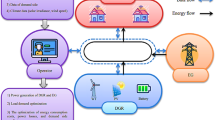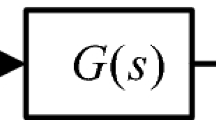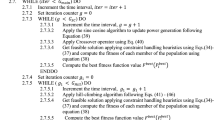Abstract
The unit commitment (UC) and economic dispatch (ED) problems are the most important problems in managing and optimizing the operations of power systems. Mixed-integer programming (MIP) seems to be one of the most exact and reliable techniques to solve the traditional UC problem, in comparison to other techniques. The solutions of the UC problem, when formulated as a MIP, involves the solutions of the ED problem. Recently, the attention is drawn to formulating a state-space model for the power generation process that can be used to solve the UC problem, for several potential reasons. First, state-space models can be easier to implement the model predictive control (MPC) strategy. Besides, state-space models are more suitable to describe the power ramping process, should more complicated models than the linear first order models are sought. Further, state-space models can be more useful when different stages of the ramping process are considered. In this work, we present a mixed-integer state-space model to solve both the UC and ED problems by considering the output power level, status of the generating unit, and up and down time counters as state variables. The up and down time counters are expressed from equalities. Numerical experiments are provided to compare the proposed model with another MIP that is not described as state-space model. The numerical results show that the proposed model is competitive, and it gives even better results for small-sized problems, especially when Piecewise Linear (PWL) objective functions are considered.
Similar content being viewed by others
References
Cohen, A.I., Sherkat, V.R.: Optimization-based methods for operations scheduling. Proc. IEEE. 75, 1574–1591 (1987)
Muckstadt, J.A., Wilson, R.C.: An application of mixed-integer programming duality to scheduling thermal generating systems. IEEE Trans. Power Appar. Syst. PAS-87, 1968–1978 (1968)
Wood, A.J, Wollenberg, B.F.: Power generation, operation, and control. Wiley, New York (1996)
Garver, L.L.: Power generation scheduling by integer programming-development of theory. AIEE Trans. Power Appar. Syst. 81, 730–735 (1963)
Garcia-González, J., Barquin, J.: Self-unit commitment of thermal units in a competitive electricity market. IEEE Power Eng. Soc. Summer Meet 4, 2278–2283 (2000)
Simoglou, C.K., Biskas, P.N., Bakirtzis, A.G.: Optimal self-scheduling of a thermal producer in short-term electricity markets by MILP. IEEE Trans. Power Syst. 25, 1965–1977 (2010)
Ritcher, C.W., Sheble, G.B.: A profit-based unit commitment GA for the competitive environment. IEEE Trans. Power Syst. 15, 715–721 (2000)
Padhy, N.P.: Unit commitment-A bibliographical survey. IEEE Trans. Power Syst. 19, 1196–1205 (2004)
Biegler, L.T., Grossmann, I.E.: Part II: future perspective on optimization. Comput. Chem. Eng. 28, 1193–1218 (2004)
Ostrowski, J., Anjos, M.F., Vannelli, A.: Tight mixed integer linear programming formulations for the unit commitment problem. IEEE Trans. Power Syst. 27, 39–46 (2012)
Arroyo, J.M., Conejo, A.J.: Optimal response of a thermal unit to an electricity spot market. IEEE Trans. Power Syst. 15, 1098–1104 (2000)
Guan, X., Luh, P.B., Yan, H.: An optimization-based method for unit commitment. Electric Power Energy Syst. 14, 9–17 (1992)
Takriti, S., Birge, J.R.: Using Integer programming to refine Lagrangian-based Unit commitment solutions. IEEE Trans. Power Syst. 15, 151–156 (2000)
Dasgupta, D., McGregor, D.R.: Thermal unit commitment using genetic algorithms. IEE Proc. Gener. Transm. Distrib. 141, 459–465 (1994)
Roque, L.A.C., Fontes, D.B.M.M., Fontes, F.A.C.C.: A hybrid biased random key genetic algorithm approach for the unit commitment problem. J. Comb. Optim. 28, 140–166 (2014)
Mantawy, A.H., Abdel-Magid, Y.L., Selim, S.Z.: Unit commitment by Tabu Search. IEE Proc. Gener. Transm. Distrib. 145, 56–64 (1998)
Ting, T.O., Rao, M.V.C., Loo, C.K.: A novel approach for unit commitment problem via an effective hybrid particle swarm optimization. IEEE Trans. Power Syst. 21, 411–418 (2006)
Chandrasekaran, K., Hemamalini, S., Simon, S.P., Padhy, N.P.: Thermal unit commitment using binary/real coded artificial bee colony algorithm. Electric Power Syst. Res. 84, 109–119 (2012)
Saneifard, S., Prasad, N.R., Smolleck, H.A.: A Fuzzy Logic approach to unit commitment. IEEE Trans. Power Syst. 12, 988–995 (1997)
Zhuang, F., Galiana, F.D.: Unit commitment by simulated annealing. IEEE Trans. Power Syst. 5, 311–318 (1990)
Sheble, G.B., Fahd, G.N.: Unit commitment literature synopsis. IEEE Trans. Power Syst. 9, 128–135 (1994)
Zheng, Q.P., Wang, J., Liu, A.L.: Stochastic optimization for unit commitment: a review. IEEE Trans. Power Syst. 30, 1913–1924 (2015)
Zheng, Q.P., Wang, J., Pardalos, P.M., Guan, Y.: A decomposition approach to the two-stage stochastic unit commitment problem. Ann. Oper. Res. 210, 387–410 (2013)
Xia, X., Zhang, J., Elaiw, A.: An application of model predictive control to the dynamic economic dispatch of power generation. Control Eng. Pract. 19, 638–648 (2011)
Fontes, F.A.C.C., Fontes, D.B.M.M., Roque, L.A.: An optimal control approach to the unit commitment problem. In: IEEE 51st Conference on Decision and Control (CDC), pp. 7069–7074 (2012)
Gui, Y., Kim, C.H., Chung, C.C., Kang, Y.C.: Intra-day unit commitment for wind farm using model predictive control method. In: IEEE Power and Energy Society General Meeting, pp. 1–5 (2013)
Warrington, J., Goulart, P., Mariéthoz, S., Morari, M.: Policy-based reserves for power systems. IEEE Trans. Power Syst. 28, 4427–4437 (2013)
Parisio, A., Rikos, E., Glielmo, L.: A model predictive control approach to microgrid operation optimization. IEEE Trans. Control Syst. Technol. 22, 1813–1827 (2014)
Tuffaha, M., Gravdahl, J.T.: Dynamic formulation of the unit commitment and economic dispatch problems. In: 16th IEEE International Conference on Industrial Technology (ICIT) (2015)
Tuffaha, M.: On the management and control of isolated power systems (Ph.D. Thesis). Norwegian University of Science and Technology, Norway (2016)
Kwatny, H.G., Bechert, T.E.: On the structure of optimal area controls in electric power networks. IEEE Trans. Autom. Control 34, 167–172 (1973)
Ross, D.W., Kim, S.: Dynamic economic dispatch of generation. In: IEEE Transactions on Power Apparatus and Systems. PAS-99, pp. 2060–2068 (1980)
Wang, C., Shahidehpour, S.M.: Ramp-rate limits in unit commitment and economic dispatch incorporating rotor fatigue effect. IEEE Trans. Power Syst. 9, 1539–1545 (1994)
Dommel, H.W., Tinney, W.F.: Optimal power flow solutions. In: IEEE Transactions on Power Apparatus and Systems. PAS-87, pp. 1866–1876 (1968)
Han, X.S., Gooi, H.B.: Effective economic dispatch model and algorithm. Electr. Power Energy Syst. 29, 113–120 (2007)
Han, X.S., Gooi, H.B., Kirschen, D.S.: Dynamic economic dispatch: feasible and optimal solutions. IEEE Trans. Power Syst. 16, 22–28 (2001)
Lorenzen, M., Bürger, M., Notarstefano, G., Allgöwer, F.: A distributed solution to the adjustable robust economic dispatch problem. In: 4th IFAC Workshop on Distributed Estimation and Control in Networked Systems, pp. 75–80 (2013)
Tanaka, M.: Real-time pricing with ramping costs: a new approach to managing a steep change in electricity demand. Energy Policy 34, 3634–3643 (2006)
Arroyo, J.M., Conejo, A.J.: Modeling of start-up and shut-down power trajectories of thermal units. IEEE Trans. Power Syst. 19, 1562–1568 (2004)
Li, T., Shahidehpour, M.: Dynamic ramping in unit commitment. IEEE Trans. Power Syst. 22, 1379–1381 (2007)
Gooi, H.B., Mendes, D.P., Bell, K.R.W., Kirschen, D.S.: Optimal scheduling of spinning reserve. IEEE Trans. Power Syst. 14, 1485–1492 (1999)
Nowak, M.P., Römisch, W.: Stochastic Lagrangian relaxation applied to power scheduling in a hydro-thermal system under uncertainty. Ann. Oper. Res. 100, 251–272 (2000)
Rajan, D., Takriti, S.: Minimum up/down polytopes of the unit commitment problem with start-up costs. IBM Research Report. http://domino.research.ibm.com/library/cyberdig.nsf/index.html (2005). Accessed 4 Dec 2012
Carrión, M., Arroyo, J.M.: A computationally efficient mixed-integer linear formulation for the thermal unit commitment problem. IEEE Trans. Power Syst. 21, 1371–1378 (2006)
Takriti, S., Krasenbrink, B., Wu, L.S.Y.: Incorporating fuel constraints and electricity spot prices into the stochastic unit commitment problem. Oper. Res. 48, 268–280 (2000)
Lee, J., Leung, J., Margot, F.: Min-up/min-down polytopes. Discrete Optim. 1, 77–85 (2004)
Yan, H., Luh, P.B., Guan, X., Rogan, P.M.: Scheduling of hydrothermal power systems. IEEE Trans. Power Syst. 8, 1358–1365 (1993)
Senjyu, T., Shimabukuro, K., Uezato, K., Funabashi, T.: A fast technique for unit commitment problem by extended priority list. IEEE Trans. Power Syst. 18, 882–888 (2003)
Gerdts, M.: A variable time transformation method for mixed-integer optimal control problems. Optimal Control Appl. Methods. 27, 169–182 (2006)
Frangioni, A., Gentile, C.: Perspective cuts for a class of convex 0–1 mixed integer programs. Math. Program. 106, 225–236 (2006)
Kazarlis, S.A., Bakirtzis, A.G., Petridis, V.: A genetic algorithm solution to the unit commitment problem. IEEE Trans. Power Syst. 11, 83–92 (1996)
Beale, E.M.L, Tomlin, J.A.: Special facilities in a general mathematical programming system for non-convex problems using ordered sets of variables. In: Proceedings of the 5th International Conference on Operations Research. vol. 69, pp. 447–454 (1970)
Author information
Authors and Affiliations
Corresponding author
Rights and permissions
About this article
Cite this article
Tuffaha, M., Gravdahl, J.T. Discrete state-space model to solve the unit commitment and economic dispatch problems. Energy Syst 8, 525–547 (2017). https://doi.org/10.1007/s12667-016-0212-x
Received:
Accepted:
Published:
Issue Date:
DOI: https://doi.org/10.1007/s12667-016-0212-x




